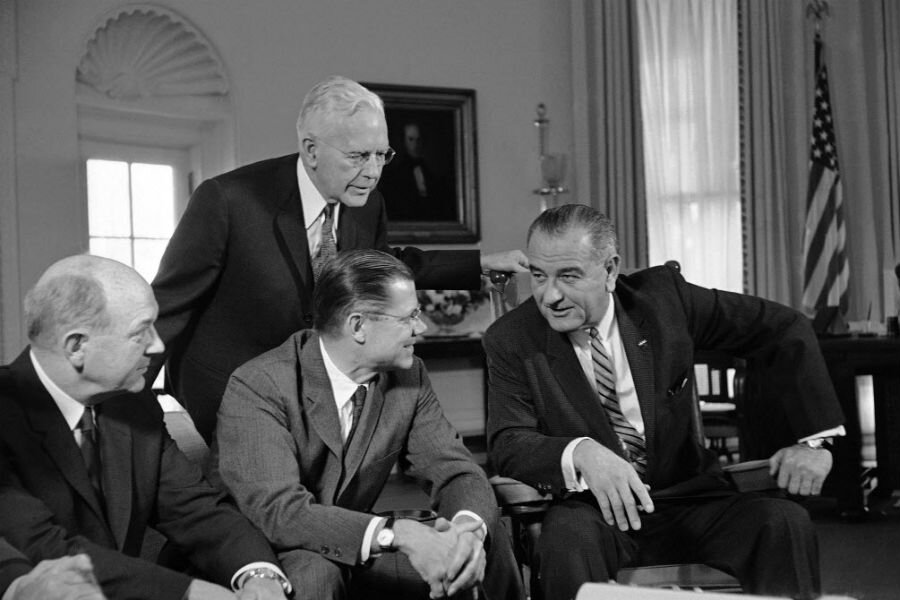50 years after Vietnam resolution, Are we any wiser?
Loading...
| New York
A dubious threat to U.S. interests. A swift vote in Congress for broad presidential war powers in response. A long, costly and bitterly debated war.
Fifty years ago Sunday, reacting to reports of a U.S. Navy encounter with enemy warships in the Gulf of Tonkin off Vietnam — reports long since discredited — President Lyndon Johnson signed a resolution passed overwhelmingly by Congress that historians call the crucial catalyst for deep American involvement in the Vietnam War. Many also see it as a cautionary tale that has gone unheeded.
"I think we are probably a bit better informed now, but I don't think that makes us a lot safer," says Edwin Moises, author of "Tonkin Gulf and the Escalation of the Vietnam War." Every era brings new foreign policy and political challenges, said the Clemson University history professor, "and I think it is utterly unpredictable what kind of misunderstandings may come along."
"If you ask whether we learned anything, I would say not enough," says former U.S. Sen. Bob Graham, a Florida Democrat who opposed the war in Iraq, long after Tonkin and Vietnam.
In the last five decades, Tonkin has not kept Washington from backing wars, but it has shadowed relations between presidents and Congress. Debates about foreign conflicts, whether in Bosnia, Syria or Iraq, have also been referendums on trust. Is the war really necessary? Is the president telling everything he knows? What should be the parameters, if any, for military action?
Graham was chairman of the intelligence committee when the Senate debated, in the fall of 2002, whether to authorize military action in Iraq. Did Saddam Hussein, as alleged by President George W. Bush's administration, possess weapons of mass destruction? Graham found the case "soft and unreliable" and voted no. But most of his colleagues disagreed. The Sept. 11, 2001, attacks were barely a year old, and the midterm election was just a month away, a difficult time to turn away the president or the Pentagon.
The Senate approved the Iraq resolution by 77-23, the House 296-133. A U.S.-led coalition invaded Iraq, opening a conflict that lasted for years. As Graham and others feared, the weapons were not found.
Former Sen. Max Cleland of Georgia, who had been badly wounded in Vietnam, was among those who supported the 2002 legislation. "I can't believe I volunteered for one war, which turned out to be a massive tragedy for the United States, and I went to the Senate and voted for another war, which turned out to be a massive tragedy," he says.
"It was right before my re-election, and I felt compelled for my own hide," explains Cleland, who nonetheless was defeated. "It became the worst vote I made in my life."
Trust in the White House was high at the time Johnson signed the Tonkin resolution on Aug. 10, 1964. The resolution was submitted and passed within 48 hours.
For months, the U.S. had been conducting clandestine missions, engaging in what historians now consider provocations. On Aug. 2, gunfire was briefly exchanged between the North Vietnamese and the Americans, leading to the sinking of a North Vietnamese boat. According to Stanley Karnow's respected history, "Vietnam," Johnson considered pushing for the resolution but decided to hold off because no Americans had been harmed.
Two days later, the commander of the destroyer Maddox, Capt. John J. Herrick, believed he had picked up radio messages communicating a planned North Vietnamese attack. The Maddox and a second vessel, the Turner Joy, began firing at what they thought were enemy patrol boats launching torpedoes against the Americans.
"But hardly had the shooting stopped than Herrick and his men began to have second thoughts," Karnow wrote. "Not a single sailor on either vessel had seen or heard enemy gunfire."
Still, reports of a second conflict, however vague, were enough to convince Johnson that it was time to act. A Pentagon spokesman denounced a "second deliberate attack," and the U.S. launched its first bombing mission against the North Vietnamese. Johnson, meanwhile, addressed the nation on television.
"Repeated acts of violence against the armed forces of the United States must be met not only with alert defense, but with positive reply. That reply is being given as I speak to you tonight," Johnson stated.
On Aug. 5, Johnson sent the resolution to Congress, where Democrats held solid majorities. The House of Representatives approved it unanimously two days later. The Senate passed it the same day 88-2; only Democrats Wayne Morse of Oregon and Sen. Ernest Gruening of Alaska voted no.
The Tonkin resolution allowed the president "to take all necessary measures to repel any armed attack against the forces of the United States and to prevent further aggression" and to assist regional allies. The resolution had no end date.
In his homespun way, Johnson likened the legislation to "grandma's nightshirt — it covered everything."
Congress rescinded the resolution in 1970, though by that time Richard Nixon was president and cited his powers as commander in chief for continuing the war. Three years later, over Nixon's veto, Congress passed the War Powers Act, which called for far greater consultation with the legislative branch.
The government itself would issue one of the harshest assessments of the Tonkin events. In 2005, 30 years after the U.S. left Vietnam and in the midst of the Iraqi conflict, the National Security Agency declassified a review concluding that the second Tonkin attack did not take place. Written by agency historian Robert J. Hanyok, the 56-page summary bluntly criticized intelligence officers.
"What was issued in the Gulf of Tonkin summaries beginning late on August 4 was deliberately skewed to support the notion that there had been an attack," Hanyok wrote. "That the NSA personnel believed that the attack happened and rationalized the contradictory evidence away is probably all that is necessary to know in order to understand what was done. They walked alone in their counsels."





